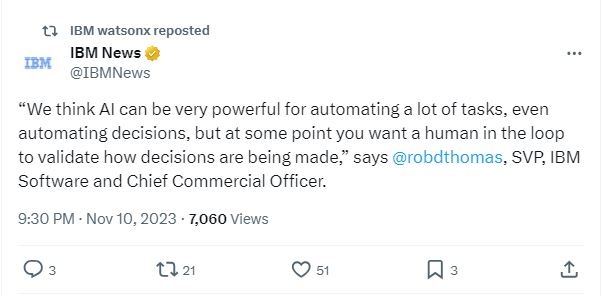
What AI trends will mark out 2024? (Image generated by AI).
IBM: the five trends in AI for 2024
- IBM unveils five AI trends it predicts will shape businesses in 2024.
- One of the biggest AI trends is that people who use AI will replace people who don’t.
- IBM also predicts that AI will have up to 3.5 times more exponential growth by 2025.
AI has dominated all tech conversations in 2023 for businesses all over the world. Today, there is not a single industry in which AI is unable to make a difference. From financial services to healthcare to tourism, AI is quickly becoming part of business plans and strategies for organizations as they plot out their future growth.
According to a report by IDC, spending on AI in the Asia Pacific region alone is expected to grow to US$78.4 billion by 2027. The increase in AI spending reflects a shift toward leveraging cutting-edge technology to reimagine operations, improve customer experiences, and maintain a competitive edge in a rapidly changing market. IDC forecasts a compound annual growth rate (CAGR) of 25.5% for the period 2022-2027.
For companies like IBM, the focus in 2024 will be on helping businesses make the most of their AI adoption and transformation. IBM predicts that AI will have up to 3.5 times more exponential growth by 2025. To achieve this, there are five trends the tech giant believes will make a difference to organizations in 2024.

AI will continue to be the main topic of discussion for enterprises in 2024.
The five AI trends of 2024
The first of the AI trends IBM sees coming in 2024 will be the shift organizations make from “plus AI” to “AI plus.” For IBM, AI plus simply means designing for AI first, and not as an afterthought. IBM’s survey said that three out of four CEOs believe competitive advantage depends on who has the most advanced generative AI.
Yet, across organizations, more than 60% are still not yet developing a consistent, enterprise-wide approach to generative AI—an essential step in responsible, trustworthy AI plus. IBM’s research shows that two out of three CEOs are acting without a clear view of how to help their workforce with the disruption and inevitable change that AI brings. And fewer than one in three CEOs have conducted an assessment on the potential impact of generative AI on their workforce. That means they probably don’t know what to tell their staff.
“To lead with responsible AI, executives and their organizations need to lead with the best of what makes us human: wisdom, ethics, and care for their stakeholders,” said Catherine Lian, managing director and technology leader for IBM Malaysia.
The second of IBM’s AI trends for 2024 is that people who use AI will replace those who don’t.
While the general idea many have is that AI will replace the workforce, the reality is that employees will be replaced not by technology but by those who know how to use the technology best.
For example, in most organizations, human resource functions are normally the pioneer when it comes to AI utilization. Employees who do not know how to work with these technologies will simply be replaced by those who can. And those that can are employees who have reskilled themselves.
“Successful AI adoption depends on teams welcoming new AI tools and applications. CEOs estimate that 40% of their workforce needs to reskill as they implement AI and automation over the next three years. Right now, with limited foresight, 87% of CEOs expect job roles to be augmented rather than replaced by generative AI. Workers must trust their new AI counterparts for success,” explained Lian.

People who use AI will replace those who don’t in 2024. (Image generated by AI).
The third trend is all about the data conversation moving out of IT and into the C-Suite. C-level executives want to understand how to use data to provide better customer experience and build a business that is tech-efficient. But there are challenges to this, especially when it comes to data security.
47% of CEOs understand that more technology increases the risk to an organization’s cybersecurity. That means the budget for cybersecurity investments is most likely to increase, with a focus on data security for AI.
“Trusting your data is more important than ever, but not just the integrity of the data itself. You also need to be able to trust that all the data crossing your virtual transom is secure and protected. Organizations that are able to monetize their large stores of trusted, high-quality data realize almost double the ROI from their AI capabilities than their peers. With these returns at risk, it’s no surprise that in 2024, data is no longer just a technology concern; it’s a business imperative with massive strategic significance,” added Lian.
The next trend in AI is to have operating models that bend so they don’t break. Building an operating model that flexes with the times, training AI models to cull patterns from unstructured external data, and incorporating internal patterns and organizational management principles allows businesses to weather shocks and respond in almost real-time. 2024 will see generative AI-enabled dashboards become even more sophisticated, enabling visibility and responsiveness to the ever-growing array of shocks.
The final trend is understanding that ecosystems are not part of the strategy, but are the strategy. As enterprises build trust with their customers, ecosystems can help or hurt. In 2024, ecosystems finally evolve from a collection of separate entities banding together to achieve separate but aligned goals. participation in ecosystems.
Open innovation is tied to revenue growth. The name of the ecosystem game is open innovation. Revenue growth among open innovation leaders is already 59% higher than peers. Yet for open innovation to prosper, data must flow freely and securely across the ecosystem.
“As leaders navigate challenges and brace for future uncertainties, they must proactively tackle these five trends set to define the business landscape in 2024 and beyond, leaning on trust to succeed,” said Lian.

As enterprises build trust with their customers, ecosystems can help – or hurt (Image generated by AI).
AI in Malaysia in 2024
Lian also spoke about the prospects of generative AI for Malaysian businesses in 2024. Currently, the main industries focused on AI investments in Malaysia are the banks, telco and aviation industries. However, Lian pointed out that other industries including government agencies are actively looking at how AI can help them improve their products and services.
While there are other tech vendors also providing generative AI services, Lian highlighted that IBM’s generative AI is focused on the watsonx AI platform. Launched at IBM’s Think event earlier this year, the watsonx AI platform includes three core components and a set of AI assistants designed to help organizations scale and accelerate the impact of AI with trusted data across their business.
The core components include a studio for new foundation models, generative AI and machine learning; a fit-for-purpose data store built on an open data lakehouse architecture; and a toolkit, to accelerate AI workflows that are built with responsibility, transparency and explainability.
“We are consistent in our strategy to make sure the data mining and data models are collated. If companies are worried about cybersecurity when investing in generative AI, IBM will be the answer. We are targeted towards enterprises that are concerned about data management and generative AI strategy,” explained Lian.
When asked about Malaysia’s Digital ID, which is expected to be implemented in the second half of 2024, Lian stated she hoped that IBM would have a part to play in its development, especially on the data management side of the program.
READ MORE
- 3 Steps to Successfully Automate Copilot for Microsoft 365 Implementation
- Trustworthy AI – the Promise of Enterprise-Friendly Generative Machine Learning with Dell and NVIDIA
- Strategies for Democratizing GenAI
- The criticality of endpoint management in cybersecurity and operations
- Ethical AI: The renewed importance of safeguarding data and customer privacy in Generative AI applications




